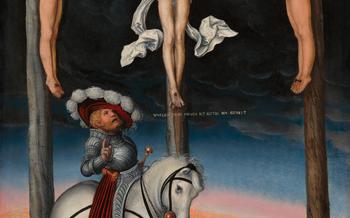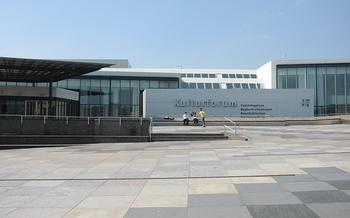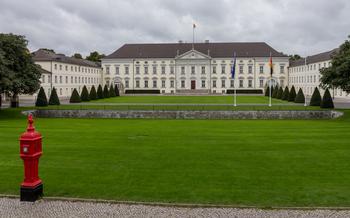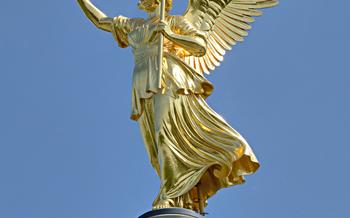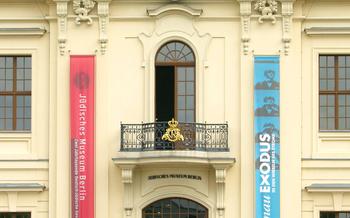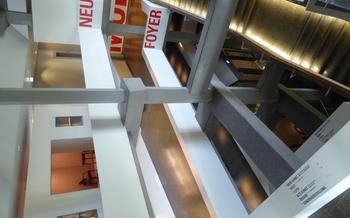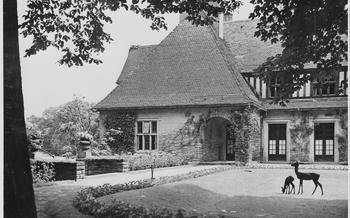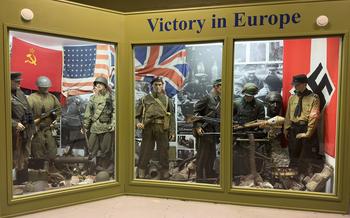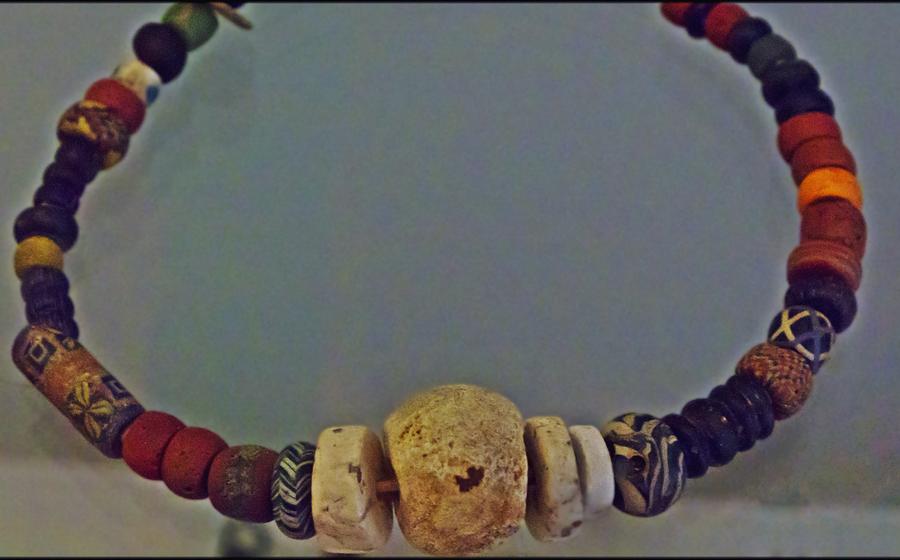
The Museum of Things (Werkbundarchiv – Museum der Dinge)
- The Museum of Things (Werkbundarchiv – Museum der Dinge)
- The Collection
- Exhibitions
- Research and Education
- Architecture and Design
- Guided Tours
- Workshops and Events
- Publications and Merchandise
- Accessibility and Inclusivity
- Family-Friendly Activities
- Temporary Exhibitions: A Glimpse into the Extraordinary
- Museum Café and Shop
- Location in Cultural District
- Sustainability Initiatives
- Insider Tip: Off-Peak Hours and the Museum's Surroundings
The Museum of Things (Werkbundarchiv – Museum der Dinge)
The Museum of Things (Werkbundarchiv – Museum der Dinge) is a unique and fascinating institution dedicated to the history, design, and significance of everyday objects. Founded in 1907 as part of the Deutscher Werkbund, a pioneering association of artists, architects, and designers, the museum's mission is to collect, preserve, and showcase objects that reflect the evolution of German design and culture.
Located in the vibrant cultural district of Berlin-Tiergarten, the museum occupies a striking building that seamlessly blends historical and modern elements. Its collection umfasst more than 100,000 objects, ranging from furniture and appliances to toys and tools, offering a comprehensive overview of the development of everyday design in Germany from the 19th century to the present day.
The Collection
The Museum of Things houses a diverse and comprehensive collection of everyday objects that spans various eras, from the late 19th century to the present day. These objects, numbering over 100,000, offer a fascinating glimpse into the evolution of design and the changing lifestyles of people throughout history.
The museum's collection is particularly renowned for its focus on everyday items, rather than the more traditional focus on fine art or decorative arts. This unique approach allows visitors to appreciate the significance of ordinary objects in shaping our daily lives and understanding the cultural and social context in which they were created.
Among the highlights of the collection are iconic design pieces, such as the Braun SK 4 record player, the Dieter Rams-designed Braun shaver, and the Apple iMac G3 computer. These objects, which have become symbols of their respective eras, demonstrate the museum's commitment to showcasing the best of industrial design and product innovation.
Exhibitions
The Museum of Things presents a diverse range of exhibitions that explore the history, significance, and impact of everyday objects in our lives. These exhibitions can be broadly categorized into two types: permanent and temporary.
Permanent exhibitions form the core of the museum's collection and provide a comprehensive overview of the history of design and everyday objects. These exhibitions showcase iconic pieces from various eras and cultures, highlighting their evolution, functionality, and cultural significance. Visitors can trace the development of everyday objects from their humble beginnings to their current sophisticated forms, gaining insights into the changing societal needs and technological advancements.
Temporary exhibitions, on the other hand, offer a fresh perspective on specific themes or designers. These exhibitions are curated to showcase unique artifacts, innovative concepts, or the works of influential designers. They provide a platform for contemporary designers to present their creations and challenge conventional notions of everyday objects. Temporary exhibitions also address current trends, social issues, and sustainability concerns, encouraging visitors to reflect on the role of design in shaping our world.
The museum's exhibitions are not merely static displays. They are designed to be interactive and engaging, inviting visitors to actively participate in the exploration of everyday objects. Interactive displays, multimedia presentations, and hands-on activities allow visitors to experience the functionality and beauty of these objects firsthand. Thematic displays group objects based on their function, material, or cultural significance, providing a deeper understanding of their role in our daily lives.
Research and Education
The Museum of Things is not just a place to display objects; it is also a hub for research and education. The museum's extensive collection serves as a valuable resource for scholars, designers, and students studying the history of everyday objects and design. Researchers have access to the museum's archives, which contain a wealth of information on the objects in the collection, as well as on the history of the museum and the Werkbund.
The museum also offers a variety of educational programs and workshops for visitors of all ages. These programs aim to foster an understanding of design history and to encourage critical thinking about the role of objects in our lives. The museum collaborates with universities and institutions to develop educational programs that are tailored to the needs of different audiences. These programs include lectures, workshops, and guided tours.
By engaging in research and education, the Museum of Things plays a vital role in preserving and disseminating knowledge about the history of everyday objects and design. The museum's commitment to research and education ensures that its collection remains a valuable resource for future generations.
Architecture and Design
The Museum of Things is housed in a striking building that seamlessly blends historical charm with modern design. Originally constructed in 1877, the building underwent extensive renovations in 2006, resulting in a harmonious fusion of old and new. The museum's architects, Kuehn Malvezzi, skillfully integrated contemporary elements into the existing structure, creating a dynamic and visually appealing space.
The building's façade retains its original brickwork and cast-iron elements, paying homage to its rich history. However, the interior has been transformed with sleek lines, glass partitions, and innovative lighting fixtures, exuding a sense of modern sophistication. The architects cleverly juxtaposed the old and the new, creating a dialogue between the past and the present.
Sustainability was a key consideration in the museum's renovation. The building incorporates energy-efficient features such as geothermal heating and cooling systems, reducing its environmental impact. The use of natural materials and recycled elements further reinforces the museum's commitment to sustainability.
The result is a striking architectural masterpiece that serves as a fitting backdrop for the museum's collection of everyday objects. The harmonious blend of historical and modern elements creates a unique and immersive experience for visitors, inviting them to explore the intersection of design, history, and sustainability.
Guided Tours
The Museum of Things offers a range of guided tours, allowing visitors to gain deeper insights into the museum's collection and the world of design. These tours are led by knowledgeable guides who share their expertise, anecdotes, and stories about the objects on display.
Types of Tours
-
General Guided Tour: Provides an overview of the museum's collection and highlights, focusing on key themes and design movements.
-
Thematic Tours: Explore specific themes or topics in greater depth, such as "Design for Everyday Life," "The History of Furniture," or "Sustainability in Design."
-
Behind-the-Scenes Tours: Offer a glimpse into the museum's storage facilities and conservation labs, providing insights into the care and preservation of the collection.
Insights from Guides
The museum's guides are passionate about design and eager to share their knowledge with visitors. They provide fascinating insights into the stories behind the objects, the designers who created them, and the cultural and historical context in which they were made.
Anecdotes and Personal Stories
The guides often share personal anecdotes and stories related to the objects on display, making the tours more engaging and memorable. These stories bring the collection to life and help visitors connect with the human aspect of design.
Workshops and Events
The Museum of Things regularly hosts a variety of workshops and events that provide visitors with opportunities to engage with design and everyday objects in a hands-on and interactive way. These programs are designed to cater to a wide range of interests and skill levels, from design enthusiasts and students to families and individuals of all ages.
Some of the popular workshops offered include product design workshops, where participants can learn about the principles of design and create their own unique products; material workshops, which focus on exploring the properties and applications of different materials; and upcycling workshops, where participants transform discarded objects into new and useful creations.
Events at the museum often revolve around specific themes or exhibitions, offering visitors a deeper dive into the museum's collection and the stories behind the objects. These events may include lectures by experts in the field of design and material culture, panel discussions, film screenings, and hands-on activities related to the exhibition's subject matter.
Participating in workshops and events at the Museum of Things is a great way to deepen one's understanding of design history and contemporary design practices, while also fostering creativity and innovation. These programs provide a unique opportunity to engage with the museum's collection in a meaningful and memorable way.
Publications and Merchandise
The Museum of Things offers a variety of publications and merchandise that allow visitors to delve deeper into the world of design and everyday objects. These publications include scholarly books, exhibition catalogs, and thematic journals, which provide in-depth analysis and insights into the museum's collection and exhibitions. Visitors can also purchase beautifully designed souvenirs, such as postcards, posters, and notebooks, featuring iconic objects from the collection. Additionally, the museum shop supports local designers and artisans by offering a carefully curated selection of design-related items, including handcrafted products, jewelry, and home accessories. These offerings not only contribute to the museum's financial sustainability but also promote the work of contemporary designers and foster a vibrant creative community.
Accessibility and Inclusivity
The Museum of Things is committed to providing an accessible and inclusive experience for all visitors. Wheelchair users and visitors with limited mobility will find the museum fully accessible, with ramps, elevators, and accessible restrooms throughout the building. Multilingual signage and audio guides are available in several languages to ensure that visitors from all over the world can enjoy the museum's exhibits. The museum also offers programs and events designed specifically for visitors with disabilities, such as sensory-friendly tours and workshops.
Family-Friendly Activities
The Museum of Things is not just for adults; it also offers a range of interactive exhibits and activities designed to engage and educate children. The museum's collection includes many everyday objects that kids can relate to, and there are hands-on displays and interactive stations that allow them to explore design and function in a fun and engaging way.
Families can participate in workshops and events specially designed for them. These activities often revolve around design, creativity, and exploration, and they provide a great opportunity for parents and children to learn and create together. The museum's friendly and knowledgeable staff is also on hand to assist families and answer any questions they may have.
With its interactive exhibits, engaging workshops, and focus on hands-on learning, the Museum of Things is a great place for families to visit and explore together. Children of all ages will find something to enjoy and learn from, making it a perfect destination for a family outing in Berlin.
Temporary Exhibitions: A Glimpse into the Extraordinary
The Museum of Things frequently hosts temporary exhibitions that delve into specific themes, showcase the works of renowned designers, or present unique artifacts from various corners of the world. These exhibitions offer visitors a chance to explore new perspectives, discover hidden stories, and gain insights into the ever-evolving world of design.
Previous temporary exhibitions have covered a wide range of topics, from the history of everyday objects to the influence of technology on design. Visitors have had the opportunity to admire exquisite furniture pieces from the Bauhaus era, explore the evolution of fashion through the decades, and gain an understanding of the design principles behind everyday products.
Temporary exhibitions are often curated in collaboration with renowned designers, institutions, or experts in their respective fields. This ensures that visitors are presented with high-quality content and a diverse range of perspectives. The museum also organizes accompanying events, such as lectures, workshops, and guided tours, to further enhance the visitor experience.
Don't miss the chance to catch these limited-time exhibitions during your visit to the Museum of Things. They offer a unique opportunity to explore new facets of design and discover hidden treasures from the world of everyday objects.
Museum Café and Shop
After exploring the fascinating exhibits, visitors can take a break and recharge at the museum's café. With its cozy ambiance and modern design, the café offers a relaxing space to enjoy a cup of coffee or tea and a delightful snack. Visitors can savor freshly baked pastries, homemade cakes, and other delectable treats while immersing themselves in the museum's creative atmosphere.
The museum shop is a treasure trove of design-related souvenirs and gifts. Visitors can find a curated selection of books, catalogs, and publications that delve deeper into the world of design and the museum's collection. Unique items, such as design-inspired jewelry, home accessories, and stationery, are also available, providing visitors with the opportunity to take a piece of the museum's creativity home with them.
By supporting the museum shop, visitors not only enhance their own experience but also contribute to the museum's mission of preserving and promoting design culture. The shop's proceeds directly support the museum's exhibitions, educational programs, and research initiatives, ensuring that the museum continues to thrive as a vibrant center for design exploration and appreciation.
Location in Cultural District
The Museum of Things is strategically situated within Berlin's vibrant cultural district, offering visitors an immersive experience that extends beyond its walls. This district is a hub of creativity and innovation, boasting an array of renowned museums, galleries, and theaters. Visitors can easily explore the area on foot, discovering hidden gems and uncovering the city's rich cultural tapestry.
The proximity to other cultural institutions allows for a seamless transition between exhibitions, performances, and events. Within a short walk, visitors can delve into the world of contemporary art at the Hamburger Bahnhof, explore the history of photography at the Helmut Newton Foundation, or catch a captivating performance at the Schaubühne am Lehniner Platz theater.
By integrating itself into this vibrant cultural ecosystem, the Museum of Things not only offers a unique perspective on design history but also invites visitors to engage with a broader dialogue on creativity, innovation, and the human experience.
Sustainability Initiatives
The Museum of Things is dedicated to sustainability and has implemented several initiatives to reduce its environmental impact. The museum's building is equipped with energy-efficient lighting systems, solar panels on the roof, and a rainwater harvesting system. The museum also uses recycled and recyclable materials in its exhibitions and displays.
In addition, the museum has a green roof terrace that provides a habitat for insects and birds. The museum also has a recycling program in place and encourages visitors to bring their reusable water bottles.
The museum's commitment to sustainability has been recognized by the German Sustainable Building Council (DGNB), which has awarded the museum a gold certificate for its sustainability efforts.
Insider Tip: Off-Peak Hours and the Museum's Surroundings
For an intimate and tranquil experience at the Museum of Things, consider visiting during the morning hours on a weekday or on a less busy day of the week. This will allow you to explore the collections and exhibitions at your own pace, without the crowds. The museum's location within the Kulturforum complex provides an excellent opportunity to combine your visit with other cultural attractions in the area. Stroll through the adjacent Tiergarten Park, admire the architectural landmarks of Potsdamer Platz, or visit the neighboring Gemäldegalerie for a glimpse into the history of Western art. By exploring the surrounding area, you can immerse yourself in Berlin's rich cultural landscape and create a memorable experience.
